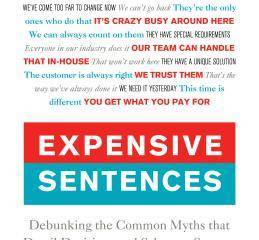The Southern Nevada Chapter of NAIOP hosted its April breakfast meeting on future development in the Las Vegas valley that portrayed challenges ahead for the marketplace.
Entitled “Building Up or Sprawling Out: The Southern Nevada Growth Debate,” the April 10 meeting of the development organization at The Orleans included Frank Maretti, founder of G2 Capital Development; Guy Martin, president of Martin Harris Construction; and John Restrepo, principal of RCG Economics. Steve Neiger, principal of CAST, moderated the discussion that examined the region’s potential shift from horizontal expansion to high-density infill development.
“Nevada is a unique state and Southern Nevada is even more unique in terms of federal ownership,” Restrepo said. “The idea that we have lots of land to develop is not true compared to other states. Some 89 percent to 90 percent of Clark County is controlled by the federal government and various federal agencies. We’re limited in our land resources, and we’ve known it. We’ve just not done enough to move things along in terms of getting more land released, which is now accelerating.”
As for density, the population per square mile in Las Vegas when compared to 36 cities in the Western U.S, the region ranks No. 13 with about 4,000 people per square mile. San Francisco is the highest at 19,000 per square mile while Scottsdale in Arizona is the lowest of those surveyed at 1,400 per square mile.
“We’re right in the middle of the pack in terms of density but the question is what do we need to do to develop and how do we develop,” Restrepo said. “Do we do greenfield development that has a lot of sprawl and negative connotations or do we match it up with in-fill developments.”
While the idea of building up “sounds cool” and what’s done in New York and Los Angeles, Restrepo said it’s expensive with high rents and high prices. That also has to be compared against the income of the population since Las Vegas has a low-wage and low-skilled workforce, he noted.
“Building up could be part of the answer but not much of an answer is the context of Southern Nevada today,” Restrepo said.
The lack of land has led to a loss of economic development opportunities of $1 billion, Neiger said in citing a study from the Las Vegas Global Economic Alliance.
“The LVGEA study is what opportunities we missed because we don’t have the ability to incentivize in Southern Nevada like other municipalities do,” Martin said in response. “I tend to be the wet blanket on land because without land the incentives don’t matter. Every 1-million-square-foot building requires 100 acres so if you think about that in broad contrast we don’t have 100-acre tracts of land. We don’t have 250 to 300 acres. We have them, but we can talk about the difference between dirt and real estate and whether it’s buildable land. The way the federal government has to discharge land is so archaic that there’s no way to offset that dirt into buildable real estate. There’s many issues in getting land back from the federal government. Are we missing deals? Yes.”
“Land is a real deal but the shackles the federal government puts upon you, be careful of what we’re asking for,” Martin said.
Restrepo said the most recent land study his firm did showed how much would be available through 2030 that met certain criteria for development. It came to about 16,000 acres, and about 10,000 of that was substandard for the types of users needed.
“The issue of land is critical, and it’s size, location and slopes that come into play from an employment standpoint,” Restrepo said. “The residential guys have more flexibility to build higher density and build on the sides of hills. They’re not as worried about the slope as the commercial guys are.”
Maretti commented how Nevada faces a difficult task because he sees the comparison between it and states like Texas and Arizona being difficult because those regions have deals predicted on privately owned land.
“We don’t have the same incentives others have because our land is so constrained,” Maretti said. “(We) are on the right path. We’re not providing a lot of incentives for stuff we already do in this state, and they are using incentives trying to bolster economic solutions that we don’t currently have in our state.”
Restrepo added another challenge of how Nevada isn’t the most regulatory-friendly state in the nation. The tax structure is friendly, but the permitting and other regulatory functions for businesses aren’t that great. Studies show that Nevada falls in the bottom half of the country, he added.
“Even when comparing ourselves to California in certain communities they are much more business friendly regulatory wise than we are here,” Restrepo said. “Phoenix is and so is Salt Lake and Denver. What is it in our regulation, permitting laws and zoning that are getting in the way and discouraging companies from coming here. We’ve heard some complaints when talking to site selectors who are surprised when they get here. They love Las Vegas and climate and they start looking at regulations to get things built and go ‘oh my gosh.’”
Restrepo said in order to bring major developments, the metro area must expand beyond the valley. While some environmentalists are against that, Restrepo said a healthy community requires a healthy economy.
“Those communities that struggle environmentally are generally poor,” Restrepo said. “The healthy ones can take care of all these issues because they have good tax revenues and strong GDP. The blend between environmental progress and economic progress are tied in together. The more rational environmentalists say we need growth.”
In talking about what could be elevated, Maretti said the most logical vertical development is residential along with offices, which he called a dirty word at this time. The residential side includes student housing, assisted living and senior housing along with apartments.
“The challenge is getting them to pencil because the cost of vertical development is significantly higher than horizontal development,” Maretti said. “Vertical retail doesn’t work in very many places in this country at all. Trying to put them into a garage unless it’s the Strip becomes very challenging. For everyday users, retail has to be convenient. We learned that on Maryland Parkway.”
From a construction standpoint, wood can be used up to five to six stories but it floors six to 14 floors where the cost increases.
Maretti said there’s not enough qualified occupants in line to afford taller buildings compared to places like Phoenix with six-story buildings being routine and waiting lists for both residents and occupants who can afford that. Salt Lake is more similar to Phoenix than Las Vegas.
There wasn’t all negative news from the session.
Restrepo called the Southern Nevada region young compared to other parts of the country and needs time to evolve to diversify its economy and get more mass transit.
“Economies and regions take a long period of time to change and with that comes growth and different types of jobs, and some of this is growing pains we are going through,” Restrepo said. “We’re trying to have aspects of a big city, but we’re not there yet from an evolutionary standpoint. We have to deal with those realities. We decided 100 years ago to put all of our eggs in the resort tourism basket. It worked well for many years but stymied us a little bit in getting that economic resilience as a city with different types of industries, jobs and universities.”










